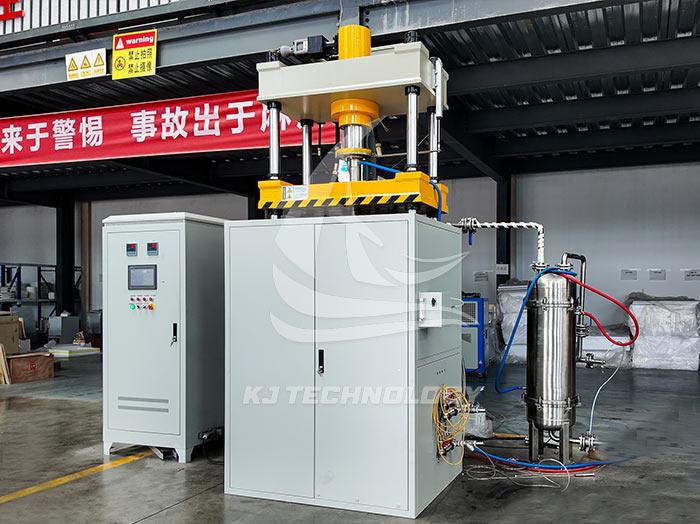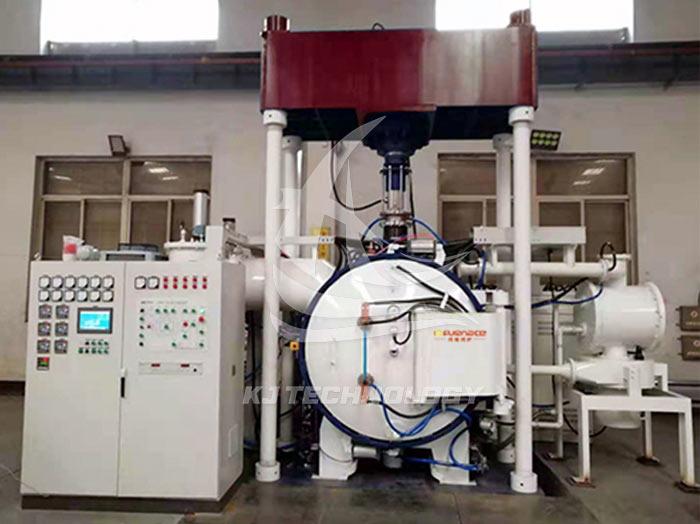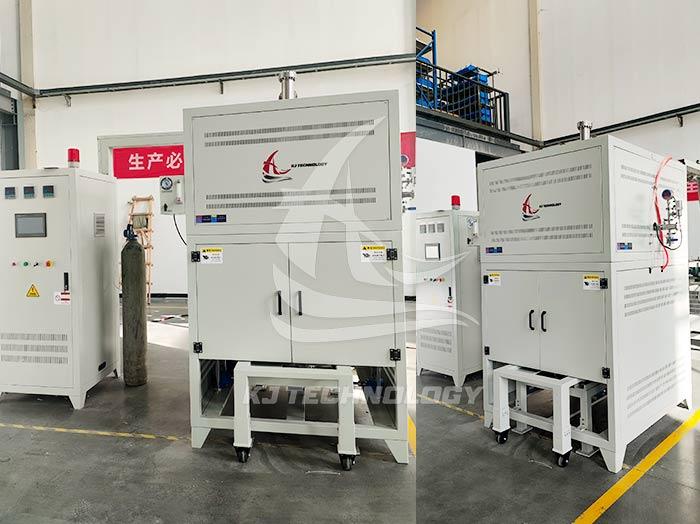What materials can be brazed in graphite high-temperature vacuum furnace?
 05-23-2025 Author: KJ technology
05-23-2025 Author: KJ technology
Graphite high-temperature vacuum furnaces are widely used in vacuum brazing processes for various materials due to their excellent high-temperature resistance (graphite can withstand temperatures above 2000 ℃ in a vacuum environment), good thermal conductivity, and thermal shock resistance. The following are the main types of materials, commonly used brazing materials, and process characteristics that can be brazed:
1. Metal material brazing
a. High temperature alloys (such as nickel based and cobalt based alloys)
Application scenarios: aircraft engine turbine blades, combustion chamber components, spacecraft high-temperature components, etc.
Solder selection:
Nickel based brazing materials (such as BNi82CrSiB): melting point of 950-1100 ℃, matching with the thermal expansion coefficient of high-temperature alloys, high joint strength (tensile strength ≥ 700MPa), and resistance to oxidation and corrosion.
Cobalt based brazing materials (such as BCo50CrNiW): melting point 1050-1200 ℃, suitable for wear-resistant and corrosion-resistant working conditions (such as gas turbine blades).
Process advantages: Vacuum environment avoids alloy oxidation, and the uniform temperature field of graphite furnace ensures no stress concentration at the joint.
b. Refractory metals (tungsten, molybdenum, tantalum, niobium)
Application scenarios: Electronic device heat sinks, high-temperature furnace components, nuclear industry structural components.
Solder selection:
Copper based brazing materials (such as Cu Ti): melting point 950-1050 ℃, using Ti element to form a diffusion layer with refractory metals to improve wettability.
Silver based brazing materials (such as Ag Cu Ti): melting point 780-850 ℃, suitable for medium strength connections such as molybdenum molybdenum and tantalum tantalum, with good conductivity.
Key points of the process: It is necessary to control the vacuum degree to ≤ 10 ⁻ Pa to avoid the formation of brittle oxides by the reaction of tungsten and molybdenum with residual oxygen at high temperatures.
c. Stainless steel and alloy steel
Application scenarios: medical devices, chemical equipment, vacuum pipelines.
Solder selection:
Silver based brazing material (such as Ag72Cu): melting point 780 ℃, high joint strength (tensile strength ≥ 300MPa), suitable for 304 and 316L stainless steel.
Copper based brazing materials (such as Cu-P): Silver free and low-cost, suitable for self brazing of iron-based alloys (P forms low melting point eutectic with Fe), but slightly weaker in corrosion resistance.
2. Ceramic metal connection
a. Aluminum oxide (Al ₂ O3), silicon carbide (SiC) ceramics and metal brazing
Application scenarios: Electronic packaging substrate (Al ₂ O ∝ ceramic+Kovar alloy), high-temperature sensor housing.
Solder selection:
Active metal brazing materials (such as Ag Cu Ti): Ti forms a TiOx transition layer with the ceramic surface, achieving metallurgical bonding with a joint strength of ≥ 200MPa.
Gold based brazing materials (such as Au Ni Cr): melting point of 950-1050 ℃, high temperature oxidation resistance, suitable for connecting Al ₂ O3 ceramics and titanium alloys.
Process characteristics: The high temperature uniformity of graphite furnace can reduce the risk of ceramic cracking due to thermal stress, and the vacuum environment prevents the oxidation of brazing materials.
b. Aluminum nitride (AlN) ceramics and metal brazing
Application scenario: High power semiconductor heat dissipation substrate (AlN+copper).
Solder selection:
Copper based active brazing materials (such as Cu Ti Zr): By reacting Ti/Zr with AlN to generate TiN and ZrN interfacial layers, the bonding strength is improved.
3. Composite material brazing
a. Metal Matrix Composite Materials (MMC)
Typical Material: Brazing of Silicon Carbide Particle Reinforced Aluminum Matrix Composite (SiC ₚ/Al) with Aluminum Alloy.
Solder selection:
Aluminum based brazing materials (such as Al Si Mg): melting point 577-612 ℃, Mg element improves the wettability of SiC particles and avoids the formation of brittle phases at the interface.
b. Carbon/carbon composite materials (C/C) connected to metals
Application scenarios: aviation brake discs, rocket engine nozzle connectors.
Solder selection:
Titanium based brazing materials (such as Ti Cu Ni): melting point 900-1000 ℃, Ti and C form a TiC transition layer, which improves the bonding strength (shear strength ≥ 150MPa).
4. Brazing of special materials and dissimilar materials
a. Superconducting materials (such as NbTi, Nb ∝ Sn)
Application scenarios: Particle accelerator magnet joints, superconducting cable connections.
Solder selection:
Tin based brazing materials (such as Sn In): melting point 118-180 ℃, maintain superconductivity at low temperatures, and avoid increasing joint resistance.
b. Combination of heterogeneous materials
Typical cases: copper titanium, molybdenum ceramic, aluminum alloy stainless steel, etc.
Solder design: It is necessary to take into account the difference in thermal expansion coefficients between the two materials (such as using silver based solder to buffer stress between copper and titanium), and the slow temperature rise and fall program of the graphite furnace can reduce thermal stress cracking.
5. Process precautions
Maintenance of graphite consumables: Graphite may react with residual water vapor to generate CO at high temperatures. It is necessary to regularly check the inner wall of the furnace tube for carbon deposits or oxide layers to avoid contaminating the workpiece.
Use of flux: Generally, flux is not required in a vacuum environment (to avoid residual contamination), but when welding high melting point oxide ceramics, chlorine free and fluorine free active flux (such as B ₂ O ∝ - SiO ₂ system) can be used.
Cooling control: For easily quenched materials (such as high carbon steel), the furnace cooling speed should be controlled (5-10 ℃/min) to prevent brittle cracking of the joint.
6. Summary
Graphite high-temperature vacuum furnace has become the core equipment for high-end brazing in aerospace, semiconductor, new energy and other fields due to its high temperature stability and vacuum cleanliness. Its applicable materials include high-temperature alloys, refractory metals, ceramics, composite materials, etc. By matching different brazing material systems and process parameters, high-strength and high reliability precision connections can be achieved. In practical applications, it is necessary to optimize the furnace temperature curve, vacuum degree, and solder composition based on material characteristics, joint performance requirements, and production costs to achieve the best brazing effect.








